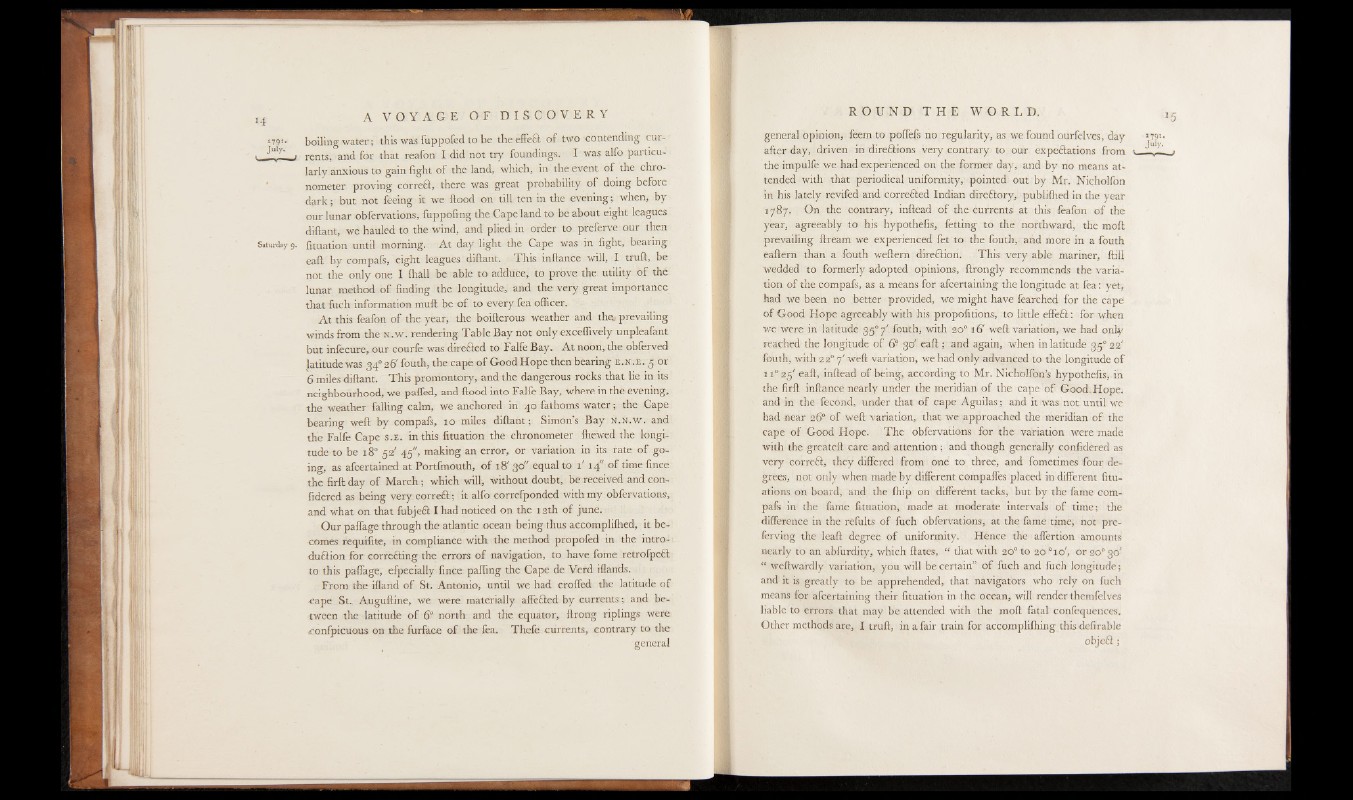
Saturday 9.
boiling water; this was fuppofed to be the effefi of two contending c u r rents,
and for that reafon I did not try foundings. I was alfo particularly
anxious to gain light of the land, which, in the event of the chronometer
proving correft, there was great probability of doing before
dark; but not feeing it we Hood on till ten in the evening; when, by
our lunar obfervations, fuppofmg the Cape land to be about eight leagues
diflant, we hauled to the wind, and plied in order to preferve our then
fituation until morning. A t day light the Cape was in fight, bearing
eaft by compafs, eight leagues diflant. This inftance will, I trull, be
not the only one I lhall be able to adduce, to prove the utility of the
lunar method of finding the longitude, and the very great importance
that fuch information mull be of to every fea officer.
A t this feafon of the year, the boifterous weather and the; prevailing
winds from the N. w . rendering Table Bay not only exceffively unpleafant
but infecure, our courfe was directed to Falfe Bay. At noon, the obferved
latitude was 340 26' fouth, the cape of Good Hope then bearing e . n . e . g or
6 miles dillant. This promontory, and the dangerous rocks that lie in its
neighbourhood, we palled, and Hood into Falfe Bay, where in the evening,
the weather falling calm, we anchored in 40 fathoms water; the Cape
bearing well by compafs, 10 miles dillant; Simon’s Bay n . n . w . and
the Falfe Cape s . e . in this fituation the chronometer Ihewed the longitude
to be 180 52' 45", making an error, or variation in its rate of going,
as afcertained at Portfmouth, of 18' 30" equal to 1' 14" of timefince
the firll day of March; which will, without doubt, be received and con-
fidered as being very correft; it alfo correfponded with my obfervations,
and what on that fubjeft I had noticed on the 12 th of june.
Our paflage through the atlantic ocean being thus accomplilhed, it becomes
requisite, in compliance with the method propofed in the intro-
duftion for correcting the errors of navigation, to have fome retrofpeft
to this paflage, efpecially fince palling the Cape de Verd illands.
From the illand of St. Antonio, until we had croffed the latitude of
Cape St- Auguftine, we were materially affefted by currents; and between
the latitude of 6° north and the equator, llrong riplings were
confpicuous on the furface of the fea. Thefe currents, contrary to the
general
general opinion, feem to poffefs no regularity, as we found ourfelves, day
after day, driven in directions very contrary to our exportations from \
the impulfe we had experienced on the former day, and by no means attended
with that periodical uniformity, pointed out by Mr. Nicholfon
in his lately revifed and corrected Indian direftory, publifhed in the year
1787. On the contrary, inllead of the currents at this feafon o f the
year, agreeably to his hypothefis, fetting to the northward, the moll
prevailing llream we experienced let to the fouth, and more in a fouth
ealtern than a fouth weltern direction. This very able mariner, Hill
wedded to formerly adopted opinions, ftrongly recommends the variation
of the compafs, as a means for afeertaining the longitude at fea; yet,
had we been no better provided, we might have feairched for the cape
of Good Hope agreeably with his propofitions, to little effefi: for when
we were in latitude 35° 7' fouth, with 20° 16' well variation, we had only
reached the longitude of 69 30' eaft ; and again, when in latitude 35° 22'
fouth, with 220 7' weft variation, we had only advanced to the longitude of
n ° 25' eaft, inllead of being, according to Mr. Nicholfon’s hypothefis,-in
the firll inftance nearly under the meridian of the cape of Good. Hope,
and in the fecond, under that o f cape Aguilas; and it was not until we
had near 26° of weft variation, that we approached the meridian o f the
cape of Good Hope. The obfervations for the variation were made
with the greateft care and attention; and though generally confidered as
very correft, they differed from one to three, and fometimes four degrees,
not only when made by different compaffes placed in different fitu-
ations on board, and the ffiip on different tacks, but by the fame compafs
in the fame fituation, made at moderate intervals of time; the
difference in the refults of fuch obfervations, at the fame time, not pre-
ferving the leaft degree of uniformity. Hence the affertion amounts
nearly to an abfurdity, which Hates, “ that with 20° to 20 To ', or 20° 30'
“ weftwafdly variation, you will be certain” of fuch and fuch longitude;
and it is greatly to be apprehended, that navigators who rely on fuch
means for afeertaining their fituation in the ocean, will render themfelves
liable to errors that may be attended with the moll fatal confequences.
Other methods are, I trull, in a fair train for accomplilhing this defirable
objeft j
1791.
July.